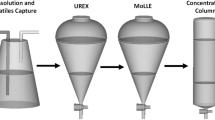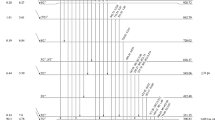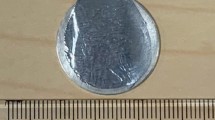Abstract
Molybdenum-99 is essential for nuclear medicine, being the parent radionuclide of 99mTc, which is commonly used in single-photon-emission computed tomography scans. Worldwide, the supply of 99Mo has faced considerable disruption twice in recent years: in 2009 triggered by the unexpected simultaneous shutdown of two nuclear research reactors, and in 2020 because of disruption to shipments of 99Mo as a consequence of severe restrictions on flights. This Perspective therefore examines alternative means of 99Mo production, via cyclotrons, electron linear accelerators and fusion neutron sources. The research and development of methods for 99Mo that can be synergic and complementary to reactors in the short-to-medium term and alternative to them in the long term is strategic for addressing potential global events that might produce reduced access to healthcare procedures relying on diagnostic as well as therapeutic radionuclides.
This is a preview of subscription content, access via your institution
Access options
Access Nature and 54 other Nature Portfolio journals
Get Nature+, our best-value online-access subscription
$29.99 / 30 days
cancel any time
Subscribe to this journal
Receive 12 digital issues and online access to articles
$99.00 per year
only $8.25 per issue
Buy this article
- Purchase on Springer Link
- Instant access to full article PDF
Prices may be subject to local taxes which are calculated during checkout





Similar content being viewed by others
References
Morillon, C., Bé, M. M., Chechev, V. & Egorov, A. Tc-99m. Table of Radionuclides Vol. 1 www.lnhb.fr/nuclides/Tc-99m_tables.pdf (2004).
Eckelman, W. C. Unparalleled contribution of technetium-99m to medicine over 5 decades. JACC Cardiovasc. Imaging 2, 364 (2009).
Israel, O. et al. Eur. J. Nucl. Med. Mol. Imaging 46, 1990 (2019).
Morillon, C., Bé, M. M., Chechev, V. & Egorov, A. Mo-99. Table of Radionuclides Vol. 1 www.lnhb.fr/nuclides/Mo-99_tables.pdf (2004).
Nuclear Energy Agency. The Supply of Medical Radioisotopes: An Assessment of Long-Term Global Demand for Technetium-99m (OECD, 2020).
Nuclear Energy Agency. The Security of Supply of Medical Radioisotopes Demand and Capacity Projections for 99Mo/99mTc for the 2023–2027 Period (OECD, 2023).
Dittrich, S. History and actual state of non-HEU fission-based Mo-99 production with low-performance research reactors. Sci. Technol. Nucl. Install. 2013, 1–9 (2013).
Nuclear Energy Agency. The Supply of Medical Radioisotopes: Review of Potential Molybdenum-99/Technetium-99m Production Technologies (OECD, 2020).
Le, V. S. 99mTc generator development: up-to-date 99mTc recovery technologies for increasing the effectiveness of 99Mo utilisation. Sci. Technol. Nucl. Install. 2014, 345252 (2014).
Gould, P. Medical isotope shortage reaches crisis level; robust solutions sought urgently to shore up fragile supply chain. Nature 460, 312–313 (2009).
Van Noorden, R. Radioisotopes: the medical testing crisis. Nature 504, 202–204 (2013).
IAEA. Non HEU Production Technologies for Molybdenum-99 and Technetium-99m. Nuclear Energy Series No. NF-T-5.4 (IAEA, 2013).
International Civil Aviation Organization. Effects of Novel Coronavirus (COVID‐19) on Civil Aviation: Economic Impact Analysis (ICAO, 2021).
Mo-99 supply put at risk by COVID-19 pandemic. Nuclear Newswire http://www.ans.org/news/article-67/mo99-supply-put-at-risk-by-covid19-pandemic/ (7 April 2020).
Gagnon, K. et al. Cyclotron produced Tc-99m on a TR24 high current target station. J. Nucl. Med. 55, 1195 (2014).
Martini, P. et al. In-house cyclotron production of high-purity Tc-99m and Tc-99m radiopharmaceuticals. Appl. Radiat. Isot. 139, 325–331 (2018).
Tsechanski, A., Bielajew, A. F., Archambault, J. P. & Mainegra-Hing, E. Electron accelerator-based production of molybdenum-99: bremsstrahlung and photoneutron generation from molybdenum vs. tungsten. Nucl. Instrum. B 366, 124–139 (2016).
Bennet, R. G., Christian, J. D. & Petti, D. A. A system of 99mTc production based on distributed electron accelerators and thermal separation. Nucl. Technol. 126, 102–121 (1999).
Nagai, Y. et al. Generation of radioisotopes with accelerator neutrons by deuterons. J. Phys. Soc. Jpn 82, 064201 (2013).
Schmor, P. Review of cyclotrons for the production of radioactive isotopes for medical and industrial applications. Rev. Accel. Sci. Technol. 4, 103–116 (2011).
Chao, A. W. & Chou, W. Rev. Accel. Sci. Technol. 10, 105 (2019).
IAEA. Cyclotron Produced Radionuclides: Principles and Practice. IAEA Technical Reports Series No. 465 (IAEA, 2009).
Gagnon, K. et al. Cyclotron production of 99mTc: experimental measurement of the 100Mo(p,x)99Mo, 99mTc and 99gTc excitation functions from 8 to 18 MeV. Nucl. Med. Biol. 38, 907–916 (2011).
Buckley, K. Cyclotron production of Tc-99m. In Proc. Cyclotrons 2013 FR2PB02, 482–486 (2013).
Berman, B. L. & Fultz, S. C. Measurements of the giant dipole resonance with monoenergetic photons. Rev. Mod. Phys. 47, 713–761 (1975).
Danos, M., Ishkhanov, B. S., Eramjan, R. A. & Yudin, N. P. Giant dipole resonance and the evolution of concepts of nuclear dynamics. Usp. Fiz. Nauk 165, 1345–1355 (1995).
Spicer, B. M. in Advances in Nuclear Physics (eds Baranger, M. & Vogt, E.) 1–78 (Springer, 1969).
Fong, A., Meyer, T. I. & Zala, K. (eds) Making Medical Isotopes: Report of the Task Force on Alternatives for Medical-Isotope Production (TRIUMF, 2008).
Balashov, V. V., Grishanova, S. I., Kabachnik, N. M. & Kulikov, V. M. Unified description of inelastic and quasielastic electron scattering from nuclei. Phys. Lett. B 36, 325–327 (1971).
Friedman, J. I. & Kendall, H. W. Deep inelastic electron scattering. Ann. Rev. Nucl. Sci. 22, 203–254 (1972).
Boffi, S., Giusti, C., Pacati, F. D. & Radici, M. Electromagnetic Response of Atomic Nuclei (Clarendon, 1996).
Tsechanski, A., Fedorchenko, D. & Starovoitova, V. On the contribution of the electronuclear reaction to the photonuclear production of Mo-99 and other radioisotopes. Rad. Phys. Chem. 177, 109108 (2020).
Pietropaolo, A. et al. The Frascati neutron generator: a multipurpose facility for physics and engineering. J. Phys. Conf. Ser. 1021, 012004 (2018).
Martone, M., Angelone, M. & Pillon, M. The 14 MeV Frascati neutron generator. J. Nucl. Mat. 212–215, 1661–1664 (1994).
Capogni, M., Pietropaolo, M. & Quintieri, L. 99mTc Production via 100Mo(n,2n)99Mo Using 14 MeV Neutrons from a D–T Neutron Source: Discussion for a Scientific Case. Report No. ENEA-RT-2016-32 (ENEA, 2016).
Capogni, M. et al. 14 MeV neutrons for 99Mo/99mTc production: experiments. Simul. Perspect. Molecules 23, 1872 (2018).
Pietropaolo, A. et al. SORGENTINA-RF project: fusion neutrons for 99Mo medical radioisotope. Eur. Phys. J. 136, 1140 (2021).
Pietropaolo, A., Capogni, M. & Quintieri, L. Secure molybdenum isotope supplies for diagnostics. Nature 603, 393 (2022).
SHINE medical isotope production facility, Janesville, Wisconsin. www.pharmaceutical-technology.com/projects/shine-medical-isotope-production-facility/ (9 March 2018).
Cervenák, J. & Lebeda, O. Experimental cross-sections for proton-induced nuclear reactions on natMo. Nucl. Instrum. Methods Phys. Res. B 380, 32–49 (2016).
Handbook on Photonuclear Data for Applications: Cross-Sections and Spectra 186 (IAEA, 2000).
Ahdida, C. et al. New capabilities of the FLUKA multi-purpose code. Front. Phys. 9, 788253 (2022).
Battistoni, G. et al. Overview of the FLUKA code. Ann. Nucl. Energy 82, 10–18 (2015).
Acknowledgements
The authors thank A. Duatti for discussions.
Author information
Authors and Affiliations
Contributions
All authors contributed to conceptualization, writing, revisions and analysis presented in the Perspective.
Corresponding author
Ethics declarations
Competing interests
The authors declare no competing interests.
Peer review
Peer review information
Nature Reviews Physics thanks the anonymous referees for their contribution to the peer review of this work.
Additional information
Publisher’s note Springer Nature remains neutral with regard to jurisdictional claims in published maps and institutional affiliations.
Related links
DAFNE: https://w3.lnf.infn.it/accelerators/dafne/
Experimental Nuclear Reaction Data (EXFOR): https://www-nds.iaea.org/exfor/
FACET-II: https://facet-ii.slac.stanford.edu/
FLUKA-CERN: https://fluka.cern
Rights and permissions
Springer Nature or its licensor (e.g. a society or other partner) holds exclusive rights to this article under a publishing agreement with the author(s) or other rightsholder(s); author self-archiving of the accepted manuscript version of this article is solely governed by the terms of such publishing agreement and applicable law.
About this article
Cite this article
Pietropaolo, A., Capogni, M. & Quintieri, L. Future of 99Mo reactor-independent supply. Nat Rev Phys (2024). https://doi.org/10.1038/s42254-024-00716-1
Accepted:
Published:
DOI: https://doi.org/10.1038/s42254-024-00716-1



